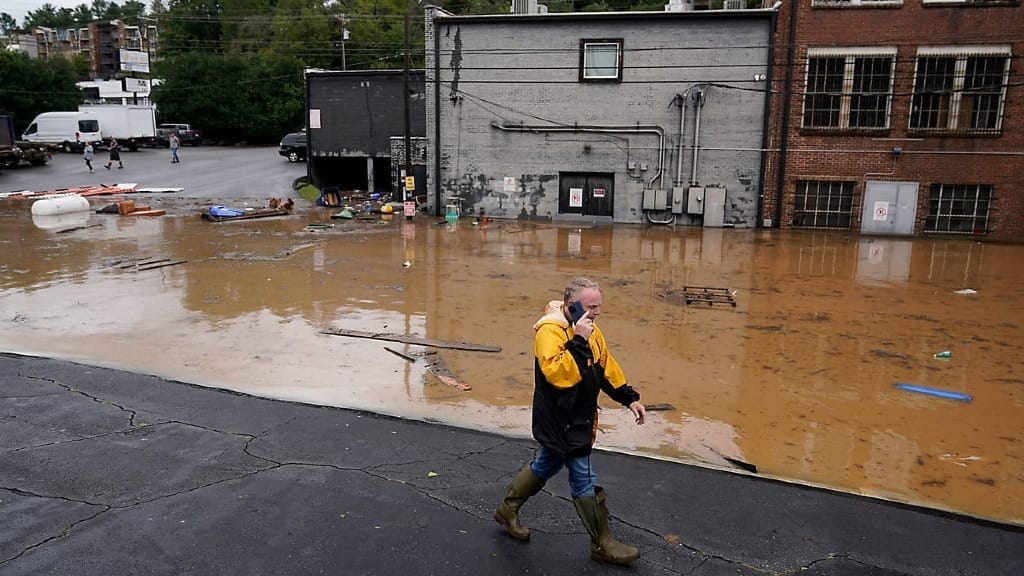ISPs Helping Recovery from Deadly Hurricane Helene
With 21.7% of cell towers down in affected regions, emergency services struggle to respond in isolated areas
Jericho Casper

WASHINGTON, Oct. 2, 2024 – Internet service providers have mobilized to bring services back online for the over one million residents across the southeastern U.S. who started the week without fixed broadband or mobile phone services following Hurricane Helene.
The Federal Communications Commission reported extensive outages Tuesday across six states, after Helene unleashed record-breaking floods in the valleys of Appalachia after making landfall Sept. 26. The hardest-hit regions were western North Carolina, South Carolina and eastern Georgia.
As of Sunday, the FCC reported that over 1 million internet connections were offline. South Carolina and Georgia each had over 300,000 customers without internet, while North Carolina reached 200,000. While these figures represent a slight improvement from the previous peak of 1.2 million on Sept. 28, connectivity remains a major challenge.
In response, major telecom operators have mobilized resources to restore wireless and wireline networks, but access to affected areas and power restoration have proven to be significant hurdles.
Verizon reported that its engineers are making progress in upstate South Carolina and east Georgia, but areas like Asheville, North Carolina, where landslides caused by flooding damaged key fiber lines, remain among the most challenging.
According to published reports, the fiber infrastructure responsible for transmitting data traffic from cell sites to command centers was severely damaged by high winds, debris, and flooding.
Verizon has deployed over 70 temporary connectivity assets, including portable cells and drones, to help restore limited service. However, customers may experience slower speeds until full fiber connectivity is restored.
Starlink, the satellite-delivered internet service provider, also announced it would offer free service for the first month to anyone impacted by the natural disaster.
Brightspeed, which serves much of the affected region, also faced significant infrastructure damage. A company spokesperson noted that nearly all fiber customers have had their service restored, while two-thirds of DSL customers and 90% of Ethernet circuits were back online.
The impact on AT&T’s network in North Carolina was particularly severe, with landslides cutting key fiber lines. AT&T, in particular, has prioritized public safety communications through its FirstNet network, ensuring first responders remain connected in areas where commercial service is still down.
Other operators, such as T-Mobile, Charter, Carolina West Wireless, and WideOpenWest, have deployed teams and equipment to restore critical communications infrastructure.
While most states have seen improvements in restoration efforts, South Carolina continues to struggle. Unlike other regions where outages are steadily decreasing, South Carolina is dealing with ongoing and newly reported infrastructure issues, particularly affecting wireline and cable users.
The overall recovery picture remains challenging, as reflected in the FCC’s report for areas impacted by Hurricane Helene.
Although the number of mobile subscribers without phone service decreased to 886,139 Monday, down from more than 1 million over the weekend, the commission reported Tuesday the number of cell sites out of service in affected counties had risen to 21.7% – up from 9.1% – on the previous day.
Around 1,889 cell sites remained out of commission on Tuesday, with the majority located in Georgia (519), North Carolina (707), and South Carolina (534).
This increase could be due to delayed reporting of damage, secondary infrastructure failures, or ongoing power outages impacting previously operational sites.
The widespread damage has also impacted emergency services, with several 911 call centers in Georgia and North Carolina rerouted without Automatic Location Identification. This means that while calls are being answered, the system cannot automatically determine the caller's location, which can delay emergency responses, particularly when callers cannot verbally provide their location.
While recovery is ongoing, telecom providers are urging customers to use text messaging and voice calls instead of data-heavy applications to reduce strain on the temporary networks. In the coming weeks, many operators will assess the overall damage to their infrastructure and consider long-term strategies for storm-hardened networks to prevent future outages.
At least 175 people were reported dead in the storm's aftermath, as the death toll rises and the search for survivors continues.









Member discussion